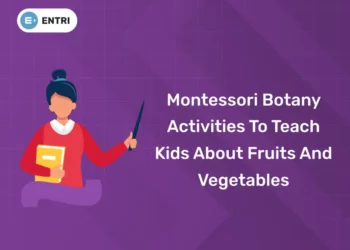Table of Contents
Introduction
The Montessori method of education, developed by Dr. Maria Montessori in the early 1900’s, is all about whole child development and independence for children. One of the main components of this is Practical Life, which are activities that help children learn life skills through hands on experience. These activities help children learn to care for themselves and their environment and concentration, coordination and self discipline. Practical Life is part of the learning experience and lays the foundation for academic success and personal growth.
In this post we will look at how to teach Practical Life in Montessori classrooms, what materials are used and why these activities are important for a child’s development. We’ll also introduce you to a valuable resource for aspiring teachers—the Entri Montessori Teachers Training Course which covers teaching Practical Life and more.
How to Teach Practical Life in Montessori
Teaching Practical Life in Montessori classrooms requires thought and intention. The aim is to encourage independence, responsibility and self mastery. Here’s a step by step guide to introducing Practical Life to children in a Montessori setting:
Ready to start a Montessori career? Join today
1. Modeling and Demonstration
The first step in teaching Practical Life is to model the activity for the child. This means to do the activity slowly and clearly, breaking it down into smaller steps. As the teacher you should demonstrate how to use each material, showing precision and care in the movements. The child will watch you and then try the activity independently.
For example if you are teaching a child to pour water from one container to another, demonstrate each movement: holding the pitcher, positioning it over the glass and pouring slowly without spilling. Children in Montessori classrooms learn by watching, absorbing and imitating.
2. Allow for Repetition
Repetition is a core principle in Montessori education. After the initial demonstration, give children the freedom to practice the activity as many times as they like. Repetition helps them refine their motor skills and master the activity. Practical Life exercises are meant to be done independently so once a child is comfortable with the activity they can do it without the teacher’s guidance.
Children get a sense of satisfaction from repeating Practical Life activities and this repetition helps them internalise the skill being taught. It also helps them concentrate and feel a sense of achievement.
3. Prepared Environment
The Montessori classroom, often referred to as the “prepared environment” is where independence is fostered. This environment has a range of Practical Life materials that are within reach of the children. Arrange these materials in a way that invites use and exploration. Ensure that everything, from the tools to the furniture, is child-sized so children can use the materials independently.
The teacher’s role is to have the classroom tidy, clean and distraction free. The prepared environment allows the children to choose which Practical Life activity they want to do, to make choices and be independent.
4. Encourage Independence
One of the main aims of Practical Life in Montessori is to encourage independence. While demonstrating the task is important, once the child starts to do the task the teacher should step back and let them figure it out for themselves. Don’t intervene unless the child asks for help or there is a safety issue.
By letting the children figure things out for themselves they build self confidence and problem solving skills. Over time they learn to trust themselves and feel brave enough to take on more complex tasks.
5. Observe and Assess
Montessori teachers are observers, watching how each child approaches Practical Life activities. Observations help the teacher to know the child’s strengths, weaknesses and preferences. It also helps them to know when the child is ready to move on to more advanced tasks or needs more support.
Observation should be done in a non intrusive way, so the child can focus on their work without feeling judged or pressured. Teachers can then give feedback, encourage self correction or introduce new activities based on the child’s progress.
Ready to start a Montessori career? Join today
What are Practical Life Materials?
Practical Life materials are tools and objects that are used in everyday life and are specifically designed for children in a Montessori classroom. These materials are functional and purposeful so children can practice real life tasks to become more independent and capable.
Here are some common categories of Practical Life materials:
1. Care of Self Materials
These materials help children to take care of themselves. Examples:
- Button frames to button and unbutton
- Shoe-tying boards to tie shoelaces
- Clothing fasteners to zip and unzip
- Hairbrushes and toothbrushes for personal hygiene
These activities help children to develop fine motor skills, coordination and self reliance in their daily routines.
2. Environment Materials
These teach children to look after their environment and take responsibility for it. Examples:
- Dusting cloths for surfaces
- Watering cans for plants
- Broom and dustpan sets for spills
- Sponges for wiping tables or after an activity
By doing these children learn to keep their environment clean and tidy and feel proud of what they do.
3. Grace and Courtesy Materials
Alongside practical tasks Montessori education places a strong emphasis on social interaction and manners. Grace and courtesy lessons teach children how to interact with others. These might include:
- Practising greetings like saying “please” and “thank you”
- Learning to offer help to others
- Role playing scenarios to practice waiting or sharing
Grace and courtesy activities help children develop social skills, empathy and self discipline.
4. Control of Movement
Practical Life also includes exercises that help children control their movements. These tasks help precision and coordination. Examples:
- Carrying trays of materials from one place to another
- Pouring water or dry materials like beans or rice without spilling
- Transfer activities using tongs, tweezers or spoons
These help children develop gross and fine motor skills which are essential for their physical development.
Why Practical Life in Montessori
Practical Life is the foundation of Montessori education, it’s the blocks on which a child’s intellectual, emotional and social development is built. These activities teach children life skills they will use for the rest of their lives and independence, concentration and a sense of achievement.
By doing Practical Life children learn to look after themselves, their environment and others. They develop problem solving skills, fine motor skills and can focus on a task for longer. But most importantly they learn to believe in themselves and trust in their ability to manage the world around them.
Learn to Teach Practical Life with Entri’s Montessori Teachers Training Course
If you are an educator interested in teaching Practical Life in a Montessori setting, you need comprehensive training. Entri’s Montessori Teachers Training Course will give you the knowledge and skills to implement Montessori in the classroom. This course covers all of the Montessori method, including Practical Life, child development and classroom management.
Entri’s course will show you how to set up a prepared environment, introduce Practical Life materials and observe and assess student progress. Whether you are a new teacher wanting to enter the Montessori world or an experienced educator wanting to upskill, Entri’s Montessori Teachers Training Course is for you.
Find out more about the Montessori Teachers Training Course at Entri.
Conclusion
1: What is the primary focus of the first plane of development in the Montessori method?
Teaching Practical Life in Montessori is about more than just showing children how to do tasks. It’s about giving them control of their lives, independence and life skills. Through modelling, repetition and observation children are guided to master these tasks by themselves. The materials and environment play a big part in encouraging exploration and growth.
By teaching Practical Life Montessori educators help children become confident, capable and independent individuals who are prepared for academic success and real life. If you want to become a Montessori teacher Entri’s Montessori Teachers Training Course is the perfect opportunity to get in-depth knowledge and hands on experience in this wonderful field.
Get Certified & Start Your Montessori Career
Montessori Teacher Training Course by Entri App: Gain expert skills, earn certification, and kickstart your teaching career.
Join Now!Frequently Asked Questions
What is the purpose of Practical Life activities in Montessori education?
Practical Life activities in Montessori education are designed to help children develop essential life skills, such as independence, coordination, and concentration, by allowing them to practice real-life tasks. These activities encourage children to take care of themselves, their environment, and others, laying the foundation for their personal and academic growth.
How do Montessori teachers introduce Practical Life activities to children?
Montessori teachers introduce Practical Life activities by modeling the task in a clear and deliberate way. They break down the activity into smaller steps, demonstrating each one slowly so the child can observe and understand. After the demonstration, the child is encouraged to practice the activity independently and repeat it as often as they like, allowing them to gain mastery.
What materials are commonly used for Practical Life activities in Montessori classrooms?
Practical Life materials in Montessori classrooms include everyday tools adapted for children, such as child-sized brooms, dustpans, watering cans, button frames, and pouring pitchers. These materials are designed to be functional and enable children to perform real tasks that help them develop fine motor skills, concentration, and a sense of responsibility.
Why is repetition important in Practical Life activities?
Repetition is crucial in Montessori education because it allows children to refine their motor skills, deepen their understanding of a task, and gain confidence in their abilities. Through repeated practice, children achieve mastery, which fosters a sense of accomplishment and helps them internalize the skills needed for both Practical Life activities and academic work.
How does the Montessori prepared environment support Practical Life activities?
The prepared environment in Montessori classrooms is carefully organized to facilitate independent exploration and learning. Child-sized materials are arranged on low shelves, making them easily accessible to children. The environment is clean, orderly, and designed to encourage children to choose their own activities, promoting autonomy and self-directed learning.
How do Practical Life activities help children develop independence?
Practical Life activities allow children to practice tasks that they will eventually need to perform independently, such as dressing themselves, preparing food, or cleaning up after activities. By giving children the tools and opportunities to practice these tasks in a supportive environment, they gradually build the confidence and skills necessary to take care of themselves without adult assistance.
What role do teachers play while children are engaged in Practical Life activities?
During Practical Life activities, Montessori teachers take on the role of observers, allowing children to work independently without interference. They provide guidance only when necessary, encouraging children to solve problems and overcome challenges on their own. This hands-off approach fosters a sense of independence and allows the teacher to assess the child’s progress.
How do Practical Life activities contribute to a child's overall development?
Practical Life activities contribute to a child’s physical, emotional, and cognitive development by teaching essential skills like coordination, concentration, and problem-solving. These activities also promote social development by helping children learn how to interact with others, practice grace and courtesy, and contribute to their community by caring for their environment.
How can teachers assess progress in Practical Life activities?
Montessori teachers assess progress in Practical Life activities by observing how children engage with the tasks. They look for signs of concentration, coordination, and the ability to complete the task independently. Teachers also consider the child’s willingness to repeat the activity and their level of satisfaction with their work as indicators of growth.











